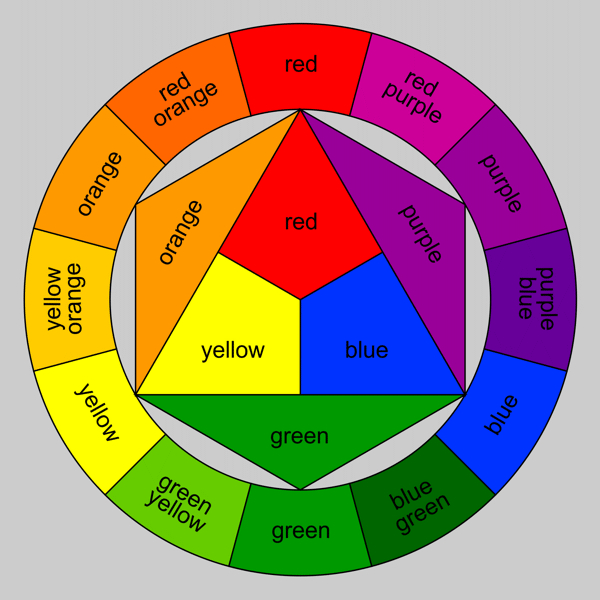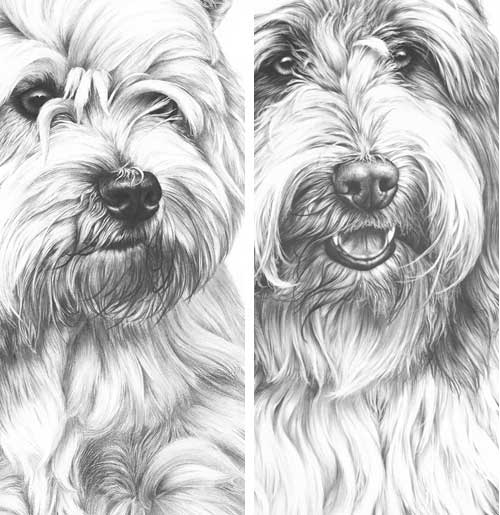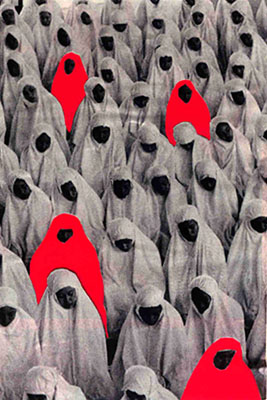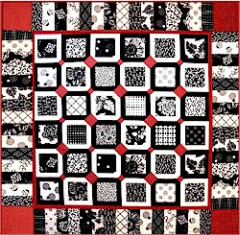The Elements of Art
The Elements of Art (EoA) describe the concrete visual and physical attributes of an art piece. They are the building blocks of Art, the basic factors the artist manipulates to create the piece as well as define the Principles of Art, which I will discuss later. An art piece is judged in part based on the EoA. There are 7 EoA.
Space
Space is exactly what it sounds like - it is the area earmarked for a purpose. It includes foreground, middleground and background. In quilting it is mainly observed as the areas inbetween the focus components of a pattern or in the pattern of the fabric. This is where your eye comes to rest from the other colors and patterns. Positive space constitues the focus pieces, and negative spaces contain the "nothingness," the spaces aside from any focus component. Space is the most basic and essential EoA.

Left: The area around the Ram is the Space in the picture. Note the spaces around the horns and body and between the legs. Right: The white is the focus, and therefore the positive space. The black is the background and non-focus space, and therefore the negative space.
In quilting, space is used so many ways it is really too vague to describe here, so I offer you this instead:

It has space and shows Space! :D
Color
This is pretty self explanitory for any art form. In terms of the EoA, this describes every aspect of color - the color choice, it's placement, it's intensity (barring tint, shade and tone which fall under the EoA "Value").

Remember this guy?
In quilting, like space, color is used in so many ways that it's near impossible to concretely describe its use here. So I offer you this instead:

It's a Color Wheel. It's a quilt. It's a Color Wheel Quilt.
Value
Value and Color go hand in hand. Value describes the lightness or darkness of a color and how it interacts in a piece. This is where you find shades, tints and tones.

Value. It has it.
Value creates highlights and shadow, and in so doing creates visual depth in a quilt.

Through the use of value, this quilt has depth and it give the visual impression of 3 dimensions.
Line
Line is a continuous mark made by a single moving point, a connection between two points, which can follow any path between the two. Line is what provides the delineation between two spaces, either with an intentional line (like a coloring book outline) or an implied line (say, the line created between two differently colored spaces), and what gives shapes their definition.

This is a great example of the use of line and its many variations and applications
In quilts, line is created by the seams, by color placement, by pattern or by block arrangement.

These blocks and applique give the impressioon of a continuous, convoluted line.
Shape
Shape defines the visual delineations of an object, and is determined by line or color. A shape is always two dimensional, and can either be geometric (with straight sides) or organic (with curved or irregular sides). To the eye, the outline of a basketball is a circle, the outline of a door is a rectangle, and the outline of a leaf is a variable, organic shape that is characterized only by that species of plant. Quilters use shape when deciding how they want their quilt to look - do they want their quilt square, rectangular, octagonal, square with rounded corners, circular, rectangular with scalloped edges? Shape dictates form.


An octagonal quilt
Form
This is the physical, three dimensional shape of the piece, or the effect of three dimensions on a two dimensional surface. Where to the eye a basketball is a circle, to the hand it is a sphere, the door is a box-like rectangle, and the leaf is a wafer thing, irregular edged sheet of plant matter.
From a shape on paper to the form of the hands.
Form determines size and function, and for a quilt, it is a very important thing to consider - does it need to be large enough to fit a Cal King bed, or is it just meant to hang on the wall? How much loft do you want to your batting? Are there any three dimentional additions to your quilt, changing it's form - buttons, ribbons, trepunto, folding? Do you want certain blocks to jump out that the observer, appearing three dimensional? A tumbling Block quilt is a great example of visual form.

This Tumbling Block quilt makes it look, through the use of value and form, like you could kick those stacked blocks over and they'd all fall down.
Texture
Texture is the either visual or physical feeling of a space, and obviously is very important in quilting. Texture can be implied visually through the use of line, color and value, like we see in lanscape fabrics in which they are made to look like woodgrain, sand or pebbles. It is also literal, giving the eye a visual texture and the hand a physical one.

The visual texture of fur here is incredible. It looks like you could touch the picture and feel that dog's fur.
This is most common when quilters mix fibers, like putting flannel and cotton, or velvet and silk together. They are viually AND physically different textures.
The use of various fibers in a quilt gives it both physical and visual texture.
Principles of Art
The Principles of Art (PoA) are the results of organizing the EoA into certain and intentional arrangements. This are also criteria by which an art piece is judged. There are nine PoA.
Balance
Balance is achieved base don the way the EoA are arranged in an art piece. By arranging Elements in a particular fashion, the artist can create feelings of heaviness or lightness, darkness or brightness.

This is somewhat asymmetrical balance.
In a quilt, this is what we consider when we want to adjust symmetry.
This quilt is balanced because of it's just about perfect symmetry.
Contrast
Contrast is the difference between two portions of a work that creates a pop, tension and interest. It helps a work to flow dynamically. With contrast, subtlety is definitely not the name of the game.

There is no higher contrast than geometric black and white.
For quilts, this is achieved mainly by color placement, value assignment and variation in block style and size compared to those it's paired with.

This quilt has high contrast color as well as block size.
Proportion
Proportion mainly deals with the size of a component as compared to the sizes of the surrounding components. it goes hand in hand with Emphasis - larger items are emphasized more than something smaller by comparison. A good example of conscious use of proportion is with charactatures - they are drawn with a person's most identifying features (small eyes, a wide mouth, chubby cheeks, a prominent chin, a delicate nose, for example) being shown the most out of proportion with what one would expect from a portrait, either drawn comically small or absurdly large.

Leonardo diCaprio, your forehead is disproportionately large compared to your face.
With quilts, this mainly is achieved with altering the focus portions of a block - stretching them in one direction or another, making one block very large while others are small, etc. For quilts, this often gives a more whimsical or fantastical feel to a quilt.

The star blocks are out of the expected proportiuon, giving this quilt a more whimsical feel.
MovementThis is a piece's "flow," how the eye moves through the piece through a guided means using the EoA. More dynamic movement in a piece gives the viewer an impression of excitement, volatility and energy. Static movement gives a sense of seriousness, calm or quiet.

This wave looks like it could crash any second. You can almost hear the sound of it. The use of movement here is highly effective!
There are entire quilt techniques built around this concept. Bargello quilts give a sense of waving movement, like a flag. Watercolor quilts have a cascading movement. It can be achieved in so many ways that a quilter must carefully (whether she/he actively thinks it or not) consider fabric choice so as not to create vibrations of a busy print in an otherwise calm piece, for example.

Here the movement is created through the quilting rather than the piecing.
Pattern/Rhythm
This PoA can also be called "rhythm" but most often you'll see it defined as Pattern. This is the repetition of EoA with the intention of creating consistent intervals of EoA, and this goes hand in hand with Movement. Pattern and Rhythm guides the eye as the artist chooses, and if used in a particular way, can give the
impression of Movement.

Pattern in the ceiling,rhythm in the repeated arches.
Pattern is prevalent in quilting, from the prints on a fabric and the placement of colors in a block, to the repetition of the blocks through a quilt.

There is distinct pattern in the blocks and in the fabric. "Yo dawg, I heard you like pattern..."
Emphasis
This is the focus of the piece, achieved by arranging the EoA and other PoA in such a way that this portion is the first thing you eye goes to upon looking at the work. This is the thing you want viewers to pay the most attention to.

One of these things is not like the other...emphasis!
In a quilt, this would be your focus fabric, your most dominant block or color.

Hey, guess where the emphasis is? Oh, and this is a good use of space, too.
Unity/Harmony
Quite simply, Unity and Harmony describe the visual completeness of a piece. If you look at something and have to ask "...is that finished? It feels like something's missing," then that piece lacks unity. Harmony comes in to play when unity is achieved using similar PoA and EoA, for exmaple using line, form, rhythm and movement to create the desired effect as opposed to focusing on color, value and emphasis.

Unity. It has it.
Quilters have to think about the whole piece, from the fabric type and color choice to blocks to accents to borders to attain untiy in their quilt, just as a painter must consider color as well as paint texture.

I think they got all their bases covered here, don't you?
Variety
Variety is exactly what it sounds like - it is the changes we see in an art piece that are different from one another. It can be achieved through use of color, emphasis, size, really any of the EoA or PoA.

Value. Depth. Contrast. Color. Emphasis. Yes, this painting has variety all right.
For quilters this means using different types of blocks, different size blocks, more than one color, different fabric types - the possibilities are endless. Having a lot of variety creates a lot of visual interest because the eye has more to process than pieces with less variety in them. That's not to say that little variety is a negative thing; many contemorpary quilts and minimalist pieces create their impact by having a single focus and little variety otherwise.

Where it lacks variety in block style, it achieves it through block size. This quilt is simple, yet it is very visually engaging
***
If you've made it this far and you're still with me, you can plainly see that all of the Elements and Principles of Art play a huge role in quilting. On the surface to many ears it seems a bold claim to declare that quilting is as legitmate an art form as sculpture and painting, but the truth of the matter is that every quilt a person makes, whether it is the result from conscious planning on the part of the quilter or not, is guided by and contains all of the Elements and Principles of Art. The next time you find yourself in a quilt shop or at a quilt show, consider these factors and you will see time and time again these criteria being met in countless different ways. On a deeper, more philosophical level, one must consider more than the observable checklist of criteria in determines what ought to be considered art and what shouldn't. So where does "folk art" fit in on that spectrum? It seems to ride the borderline between being art and being a craft, but where does that distinction lie, and why is there such a hugely different connotation between the two? That is up to you to decide for yourself.
In my opinion, I truely consider quilting an art as it meets the observable criteria, there is purpose and meaning behind it, it requires artistic thought, and it requires a skill set that isn't innate - while anyone can do it, it still must be learned and practiced. To me, quilting is relgated to the oft-sniffed at concept of Folk Art ("it's not real art, but it is art in a way") because its roots aren't found in wealth, prestige and lofty ideals the way the formal arts claim their roots in the great ancient civilizations with works made for royalty and religion. Quilting has its roots in the ground, among the dust and the dirt, with pioneers, working class, and the elite alike. The skills required for quilting have more practical origins than do other arts - sewing has been a necessity since humankind figured out that clothing is a real asset to possess - and as such the attitude of "well, it's just sewing, anyone can sew" has both helped and hindered quilting as an art. The formal art community may not see the artistic merit of quilting on those grounds alone, not to mention the fact that it is a functional piece of art and not merely a decorative art. Again, the lines are blurred and you can find many an article and argument for both sides of the Art community versus Quilting community, is it art, is it not arguement. This is simply my own opinion based on my observations and academic research work (quilting was my Anthropological thesis after all) - I encourage you to look out there and make your own decision as to whether quilting is, is not or is both.
I encourage and welcome your discussion about quilting as art in the comments section below. Please tell me what you think and let's have a debate of our own!
Sources and Additional Information
Elements and Principles of Art Slideshow
Good ol' Fashioned Wikipedia (taken with a grain of salt, of course)
International Quilt Study Center & Museum

If architecture is art I don't see why quilting wouldn't be. I believe that art is what you feel, like how quilting makes me feel creative and happy. I can feel, and everyone around me can tell, that it's an outlet for me!
ReplyDeleteArt is something that evokes feelings in you and is inspiring. I don't understand how anyone can shun the beauty of a quilt (especially lauren's) and call it unsophisticated, but then see a yellow splotch of paint 5'x5' canvas canvas true art. (silly people ^^ no offens meant to anyone)
I was just led to your blog by craft gossip. This is a version of the question that continues to puzzle me. I believe that a quilt is art for the reasons you stated, but my question is whether or not all quilters are artists. Obviously someone who is creating their own patterns and picking out their own fabrics would be an artist, but what about someone who is following a pattern with clear directions on what fabric colors to use or even using a kit with all of the choices made. To me this seems the same as calling someone who does a paint-by-number an artist. (I say this as someone who's only recently started quilting and am currently using a charm pack to make my second quilt.) Is it possible to create art without being an artist?
ReplyDeleteKymberly, I apologize it's taken me so long to reply! Life has been wild and weird :-) Now to your question.
ReplyDeleteI think it is a reasonable assumption that doing a paint by numbers isn't artistry in it's purest form, but it still is the act of creating art. For me, I would say there it focuses less on the skill side of thngs and more on the personal meaning with art. Using kits and following patterns verbatim I think is to quilting as cover songs are to music - while not the makers own design, it still has their flair to it whether they try to inject it in there or not. If a person isn't comfortable completely choosing their own colors or doesn't have the skill set to create a pattern and have the math work out (I definitely don't on the latter lol), I feel like what they do is still art because it still has their enjoyment, their time, their effort invested into to which for me is a huge part of art. What do you think?